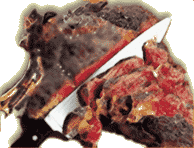Barnes & Conti Newsletter: July 2002
 Those
Lazy, Crazy, Hazy—and in Our Case, Foggy—Days of Summer
Those
Lazy, Crazy, Hazy—and in Our Case, Foggy—Days of Summer
With ASTD behind us and fog rolling across the San Francisco Bay—keeping our office naturally air-conditioned—summer is well under way. We had a very successful and enjoyable time at ASTD. We were delighted to meet so many new people from near and far: those who attended the session that Kim McGraw from Procter and Gamble and I delivered, and those who stopped by our booth. It was wonderful, also, to reconnect with old friends, colleagues, and customers. To new friends and colleagues whom we met at ASTD, I want to add a special word of welcome to our “community.”
For this summer issue, I’ve included an article about negotiating for project managers and leaders; I hope those of you who have that challenging role will find it useful. I also want to introduce one of our U.S. partners—and share an article from our partner organization about IT leadership. This newsletter also features a complete menu for your summer grilling (and eating) pleasure; all the recipes were inspired by a summer spent in Tuscany not too long ago.
—Kim
In this Issue:
- “Negotiating in Project Management: Typical Issues by Phase” by B. Kim Barnes
- Kim Barnes to Speak on “Constructive Negotiation in Project Management” at PMI in Orlando
- Introducing our Partner in Indianapolis
- “IT Leadership Alchemy: The Criticality of Technical Leadership” by Lou Russell
- News Items: Exercising Influence: Electronic Prework Available
- Recipes: For the Summer Grill
- Just for Fun: Process Optimization, Administratium—New Element Discovered.
-
Featured Art: “Landscape Near Aix, the Plain of the Arc River,” Paul Cezzane
Negotiating
in Project Management:
Typical Issues by Phase (excerpt)
B. Kim Barnes, Barnes & Conti President and CEO
Projects are built on agreements. To achieve outstanding business results, project managers and leaders must negotiate with sponsors or clients, customers, team members, and colleagues with key resources. Building effective project agreements requires the negotiators to find ways to meet the needs of all parties. A negotiation is neither a contest nor a debate. It is more like the process of creating a building with the other people who are going to have to live or work in it. The phases of negotiation are similar to the phases of designing and constructing a building.
 Constructing
a building is, of course, a big project. A few months after a building has
been completed, architects hold a “post-occupancy evaluation.” They
interview the people who live and work in the building. This provides the architects
with good information about what works well and what is less successful—information
they will use in designing their next project.
Constructing
a building is, of course, a big project. A few months after a building has
been completed, architects hold a “post-occupancy evaluation.” They
interview the people who live and work in the building. This provides the architects
with good information about what works well and what is less successful—information
they will use in designing their next project.
Negotiators would do well to adopt a similar “post-negotiation evaluation” practice, especially when they are in business relationships that require regular or frequent negotiation or close monitoring to be sure an agreement is being implemented on an ongoing basis. In fact, this kind of evaluation is done by many highly-skilled negotiators. At some time before they need to begin a new round of negotiations, they meet with the other party or parties to discuss the merits and shortcomings of their previous agreement. The discussion should include both the content and the process of coming to agreement. The discussion and evaluation prepares them for the new negotiation, establishes a collaborative negotiation relationship, and keeps them engaged in continuous improvement. Even when their next similar negotiation is with other parties, the learning will be useful and all who participate will benefit if the discussion is limited to “what did we learn from the last negotiation?” rather than “whose fault is it that I didn’t get the result I wanted?”
Negotiation is often seen as a means to resolve conflict—but it is also one of the most important tools for its prevention. Ideally, negotiation with the project client or sponsor occurs early in the life of a project, thus preventing later conflicts and misunderstandings. Other negotiations will occur throughout the life of the project, from Initiation through Planning, Execution, Control, and Closeout.
To view the complete article, go to www.barnesconti.com/newsletters/negotiatingpm.html
 Kim
Barnes to Speak at PMI Conference in Orlando
Kim
Barnes to Speak at PMI Conference in Orlando
Topic: “Building Project Agreements that Work: Constructive
Negotiation in Project Management”
When: Tuesday, July 30, 10:45 AM to 12:00 Noon
Barnes & Conti President and CEO Kim Barnes will be presenting “Building Project Agreements that Work: Constructive Negotiation in Project Management” at this year’s Professional Development Symposium ‘02 (PDS ‘02) for the Project Management Institute-Information Systems Specific Interest Group (PMI-ISSIG) this July in Orlando, Florida.
For
a full session description, click here
or go to /www.barnesconti.com/PMISession.html
 Introducing
Barnes & Conti Midwest Partner:
Introducing
Barnes & Conti Midwest Partner:
Russell Martin and Associates
Indianapolis-based Russell Martin and Associates has been helping employees and executives of companies ranging from small businesses to members of the Fortune 500 improve planning, process, and performance. Clients describe their methods as fresh, fun—and most of all, effective.
They offer a wide variety of consulting services and workshops, including Exercising Influence for Project Success—based on our own Exercising Influence workshop—and Intelligent Risk-Taking.
To learn more about their service and workshops, visit their website at www.russellmartin.com. We’d also like to introduce you to Lou Russell, President of Russell Martin & Associates, through her article, below.
IT Leadership Alchemy:
The Criticality of Technical Leadership (excerpt)
Lou Russell, President, Russell Martin & Associates
...In general, the toughest challenges of leading IT people are
no different than those of leading other professionals. Getting the best out
of people and having them work with each other to achieve a common goal requires
the same skills whether you’re leading a sales team or a technology group.
The critical leadership skills cut across all parts of an organization. However,
IT practitioners are a unique group of individuals with preferences and behaviors
that may be different than other business professionals.
- IT leadership deals with a unique group of highly intelligent, technical people immersed in the innate unpredictability and chaos of technology.
- A great IT leader needs to know how to leverage the strengths she already has, and to surround herself with others to fill in her own gaps. A great IT leader realizes that each of her people is unique and coaches them to leverage their own strengths. Therefore, IT leadership, like all leadership, is about releasing the potential that is already there.
- Leadership development is a paradox. It must be practical, and immediate. However, to be able to “do,” leaders must find quiet time to develop self-understanding. There is a strong tension between the need to act quickly and the need to stop and think. Leadership requires both.
To read the complete article, go to www.barnesconti.com/newsletters/itleadership.html
What’s New at Barnes & Conti?
Exercising Influence: Online Prework Available
We’re happy to announce that the prework assessment for Exercising Influence is now available online via the World Wide Web. Participants can now assess their ability to exercise influence, invite up to five colleagues to do the same, and view and print the compiled results right in their web browsers
If you have scheduled Exercising Influence, or are considering doing so, and want to use the online prework, please let us know next time you schedule or confirm, and we’ll send you the instructions.
To read about the features and requirements for using the online prework, click here.
Upcoming Public Programs
Exercising Influence™
August 6-7, 2002, Milpitas (San Jose), CA
September 10-11, 2002, San Francisco, CA
Intelligent Risk-Taking™
October 8-9, 2002. San Francisco, CA
C.O.A.C.H. for Peak Performance
August 14, 2002, Milpitas (San Jose), CA
To register
for one of our public programs, click here
or go to: www.barnesconti.com/ppsched.php
For the Summer Grill
 We
wanted to offer something different from the usual steaks, burgers, hot dogs,
chicken, and special-recipe barbecue sauce for your summer grill. Not so long
ago, Kim and her husband Don brought the beef recipe back from the summer they
spent in Tuscany. The other recipes were chosen to compliment the beef.
We
wanted to offer something different from the usual steaks, burgers, hot dogs,
chicken, and special-recipe barbecue sauce for your summer grill. Not so long
ago, Kim and her husband Don brought the beef recipe back from the summer they
spent in Tuscany. The other recipes were chosen to compliment the beef.
- Tagliata di manzo
- Bruschetta
- Grilled Summer Vegetables
- Penne Pasta with Tomatoes, Basil, Olive Oil and Garlic.
Tagliata di manzo (Grilled Sliced Beef)
Ingredients:
- Steak (boneless sirloin or ribeye) 1.5 - 2 lbs. (allow 1/3 lb. to 1/2 lb. per person)
Flavored oil (soffrito):
- 2-3 tbsp. Extra Virgin Olive Oil
- 6-8 medium - large cloves garlic, sliced
- 6 sprigs of rosemary
Optional Marinade (not really authentic, but tasty):
- 2 cloves garlic, pressed
- 2 tsp. chopped, fresh rosemary
- Dry red wine to cover (3/4 cup).
The Instructions:
- Salt and pepper the steak to taste.
- (Optional) If you want to marinate the beef, make the marinade, and marinate for at least 45 minutes.
- Make the flavored oil by heating together the olive oil, garlic, and rosemary over medium heat and sautéing gently until the garlic is colored a light golden brown; keep oil warm.
- Grill the beef until it is medium rare to rare (3-4 minutes per side per inch of thickness, over a hot fire).
- Let the beef sit for at least 10-15 minutes before slicing. Slice across the grain into long thin slices, no thicker than 1/4 inch.
- Drizzle with the flavored oil and serve warm, or at room temperature.
Variation (you must make the marinade for this): Strain the marinade, cook down to reduce by 2/3, add a tablespoon of chopped parsley and a splash of good balsamic vinegar, and drizzle onto the beef slices with the flavored oil.
Chianti, sangiovese, or (on really hot days) a chilled dry rose are the recommended libations.
Bruschetta
Real, Tuscan bruschetta is nothing more than good bread, sliced thick and grilled until it is lightly toasted. When it comes off the grill, rub the bread with a cut clove of garlic, and drizzle extra virgin olive oil on it.
Grilled Summer Vegetables
 Use
any or all of the following:
Use
any or all of the following:
-
Eggplant
-
Zucchini
-
Bell Peppers (red and yellow)
-
Tomatoes
-
Sweet onions
-
Mushrooms (trimmed of stems).
Leave the smaller vegetables and the tomatoes whole. Cut zucchini, onions, bell peppers, and small eggplant in half lengthwise. Slice large eggplant into thick slices.
Grill the vegetables (start cut side down) for several minutes on each side, until the vegetable begin to char slightly and lose some liquid. Turn and repeat on the other side. Timings vary with the hotness of the flame and the size of the vegetables.
In general, onions, zucchini, and eggplant cook the slowest. Mushrooms should be grilled “cap side down” until the cap starts to shrivel and brown a bit; mushrooms need not be turned.
These vegetables really don’t need seasoning, but if you must, try extra virgin olive oil and a few drops of good balsamic vinegar.
Penne Pasta with Tomatoes, Basil, Garlic, and Olive Oil
Ingredients:
-
1 lb. Penne, or other tubular pasta
-
5-6 ripe tomatoes, diced
-
12-16 basil leaves, shredded or torn
-
3 tbsp extra virgin olive oil
-
2 large cloves garlic, minced
-
Optional: crumbled goat cheese or shredded fresh (or buffala) mozzarella
Instructions:
-
Cook the pasta in boiling , salted water until al dente
-
While the pasta is cooking, gently saute the garlic in the olive oil until the garlic begins to color.
-
Transfer oil and garlic to a pasta mixing bowl. Add the tomatoes and basil to the olive oil.
-
When the pasta is done, drain well, and toss with the tomato/basil/garlic/olive oil mixture.
-
Add optional cheeses while the pasta is hot.
-
Serve warm or at room temperature.
Just for Fun
Process Optimization
The construction team leader noticed that one team member was pushing his wheelbarrow upside down. “Hey,” he shouted, “turn that thing right side up!”
“Don’t be silly,” the man replied. “Every time I do that, they put bricks in it.”
Adminstratium
A major research institution has recently announced the discovery of the heaviest element yet known to science. This new element has been tentatively named “Administratium.”
Administratium has 1 neutron, 12 assistant neutrons, 75 deputy neutrons, and 111 assistant deputy neutrons, giving it an atomic mass of 312. These 312 particles are held together by a force called morons, which are surrounded by vast quantities of lepton-like particles called peons. Since Administratium has no electrons, it is inert.
However, it can be detected as it impedes every reaction with which it comes into contact. A minute amount of Administratium causes one reaction to take over 4 days to complete when it would normally take less than 4 seconds.
Administratium has a normal half-life of 3 years; it does not decay but instead undergoes a reorganization in which a portion of the assistant neutrons and deputy neutrons exchange places. In fact, Administratium’s mass will actually increase over time, since each reorganization causes some morons to become neutrons, forming isodopes. This characteristic of moron-promotion leads some scientists to speculate that Administratium is formed whenever morons reach a certain quantity in concentration. This hypothetical quantity is referred to as “Critical Morass.” You will know it when you see it.
(source unknown)
Please send feedback to newsltr1
at barnesconti.com
Barnes & Conti, 940 Dwight Way Suite 15, Berkeley, CA 94710, USA
Copyright © 2004 Barnes & Conti Associates, Inc. ALL RIGHTS
RESERVED.
Barnes & Conti is a spam-free zone. We do not sell, trade, or give email addresses to anyone.
